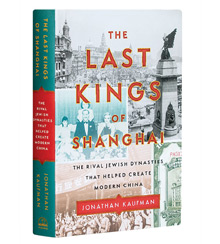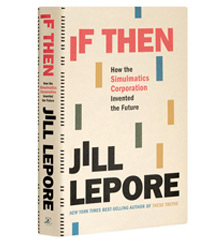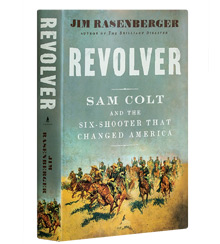Best Business Books 2020: Narratives
Gunning for history
Jonathan Kaufman
The Last Kings of Shanghai: The Rival Jewish Dynasties That Helped Create Modern China (Viking, 2020)
Jill Lepore
If Then: How the Simulmatics Corporation Invented the Future (Liveright, 2020)
Jim Rasenberger
Revolver: Sam Colt and the Six-Shooter That Changed America (Scribner, 2020)
*A TOP SHELF PICK
“The only thing that matters is the future. I don’t even know why we study history…what already happened doesn’t really matter.” So said Anthony Levandowski, an engineer designing self-driving cars who’d played key roles at Google and Uber, back when Silicon Valley was taking over the world. In her new book, If Then: How the Simulmatics Corporation Invented the Future, Harvard historian and New Yorker writer Jill Lepore quotes Levandowski, not because she agrees with him, but because she doesn’t. Lepore knows that the past is always present, which is something she shares with Jonathan Kaufman and Jim Rasenberger, the authors, respectively, of this year’s other best business books in the form of historical narratives, The Last Kings of Shanghai: The Rival Jewish Dynasties That Helped Create Modern China and Revolver: Sam Colt and the Six-Shooter That Changed America.
The revelatory The Last Kings tells the story of two Jewish dynasties that were rooted in Baghdad, the Kadoories and the Sassoons, and the role they played in building Shanghai. The issues they faced still resonate today. “Long before Mark Zuckerberg, Steve Jobs, Microsoft, and Google grappled with how to deal with China and political pressures in the United States, the Sassoons and the Kadoories, with their offices in Shanghai, Hong Kong, Bombay, and London, mastered the global economy and struggled with the moral and political dilemmas of working with China,” Kaufman writes.
The fascinating narrative laid out by Kaufman, who reported from China for the Boston Globe and the Wall Street Journal and now directs Northeastern University’s journalism program, is one of imperialism. After their victory in the first Opium War, in 1842, the British (who were complicit in the addiction of millions of Chinese to opium) effectively annexed Shanghai by using the astounding doctrine of extraterritoriality, which meant that non-Chinese citizens and businesses weren’t subject to Chinese law. No wonder that, Kaufman notes, “In elementary school classrooms across China there is a poster that declares WU WANG GUO CHI — NEVER FORGET NATIONAL HUMILIATION.”
In time, the immense anger stirred up by foreign interference and dramatic inequality unseated the Qing dynasty and eventually led to communism. But for a long time, even as China convulsed, Shanghai rose. Between the World Wars, it was the most cosmopolitan city in the world: glamorous, alive with economic opportunity, and richly multicultural. “There never was and never will be another city like Shanghai between the two wars,” Lawrence Kadoorie would recall years later.
The Kadoories and the Sassoons were at the center of it all. The Kadoories built the lavish Marble Hall. Modeled on Versailles, it was the city’s largest mansion, with a dining room that could seat 50 and a garage that held several Rolls-Royces. They also built a hotel on the famous Bund waterfront along the Huangpu River called the Majestic, which became a destination for celebrities the world over. The Sassoons countered with their own splashy hotel, the Cathay, which had the very latest in the prosaic (indoor plumbing) and the glamorous (an arcade with shops selling au courant luxury items from Paris). Noel Coward wrote a draft of Private Lives in a suite at the Cathay.
The Sassoons arrived in China first. The family, often referred to as “the Rothschilds of the East,” rose to prominence and wealth in Baghdad in the 1800s as traders and financiers, so much so that patriarch David Sassoon started a system under which Sassoon schools trained young Jews to become employees in the family firm. When Baghdad became inhospitable to Jews, the Sassoons followed the British Empire east — reestablishing themselves first in Bombay, in the 1830s, and then in Shanghai, in the 1840s. They prospered by trading in opium, and then cotton and textiles. Of course, there was family chaos, but out of it came Victor Sassoon (1881–1961) — a bon vivant who was considered by even his own employees to be a “dilettante figurehead.” When Fortune, in 1935, published a lavish feature on the Shanghai boom, the magazine gave all the credit to Victor Sassoon: “Victor gave Shanghai its glamour, its frisson, its mystery.”
The founder of the Kadoorie dynasty, Elly Kadoorie, actually got his start at the Sassoon schools in Bombay, and first arrived in Shanghai as a Sassoon employee. Family legend has it that he quit amid much furor after using a disinfectant without the permission of his superiors to rid a building of the fleas and rats that were spreading bubonic plague.
Whatever their sins in furthering imperialism, both families were rehabilitated into saviors in the 20th century. By the late 1930s, Jewish refugees were pouring out of Nazi-controlled Europe. Country after country refused to take them in, but Shanghai welcomed them. With substantial money and support from the Kadoories and Sassoons, thousands of Jews rode out the war in a Shanghai ghetto — among them artist Peter Max and Harvard Law professor Laurence Tribe, who was born in the city. Thanks in part to the influence of the families, the Jewish community was protected even after Japan joined the Axis and took over Shanghai. (His mansion confiscated, Elly Kadoorie ultimately died in the Shanghai ghetto in 1944.)
Victor Sassoon “saw himself as the consummate political insider” and certainly had moments of astounding prescience. “The West will never be able to keep furnishing the Orient with industrial manufactures if it does not also provide some means to increase the buying power of the people the machine-made goods are intended for,” he wrote in 1932. But in the 1940s, he allied himself with China’s Nationalists, failing to see that the forces remaking the country would ultimately affect his fortune, and not comprehending the role his family played in stoking the mounting fervor. When the Communists triumphed in 1949, the Sassoons lost almost everything.
An embittered Sassoon decamped to the Bahamas and never rebuilt. The Sassoon money quickly dissipated. The Kadoories, on the other hand, who owned a controlling stake in China Light and Power, became Hong Kong’s first billionaire family. Operating in what remained a fragile British colony, Elly’s sons Lawrence and Horace understood that they needed the support of the residents, and so they advocated for policies that more closely resembled the New Deal than the free-for-all imperialism of the past. “Horace and Lawrence Kadoorie, declared an Australian publisher after meeting them, were the two most effective anti-Communists Asia had produced,” Kaufman writes.
They seem to have gleaned some wisdom from their family’s remarkable history. Lawrence Kadoorie, who died in 1993, always kept a tattered brown-and-white Humpty Dumpty doll on the leather chair behind his vast oval desk. He did so, he said, “to remind me that Humpty Dumpty took a great fall.” In 1970, a journalist asked Lawrence if it was true that he owned a giant computer that could forecast when China would take back Hong Kong. “I fear you have been misinformed about my powers and those of a computer,” he replied. “Neither of us tell fortunes.”
Artificial intelligence?
By the time Lawrence Kadoorie uttered those words, Simulmatics, which was founded in 1959 on the premise that a computer could not only tell but also influence the future, had already gone bankrupt. The name of the company was a contraction of the words simulation and automatic, and its founders, who were trying to build something they called the “people machine,” believed that, as Jill Lepore writes in If Then, “if they could collect enough data about enough people and feed it into a machine, everything, one day, might be predictable, and everyone, every human mind, simulated, each act anticipated, automatically, and even driven and directed, by targeted messages as unerring as missiles.”
In this way, Simulmatics was the forgotten precursor to Amazon, Facebook, and Google. (A 1964 novel called Simulacron-3, which was based on Simulmatics, was a forerunner to The Matrix.) And Lepore, whose most recent books were the sweeping narrative history These Truths: A History of the United States and This America: The Case for the Nation, focuses her lens on this forgotten company to unearth enduring lessons. The idea that machines could master the ancient art of prophecy was in vogue in the 1950s — simultaneously popular in the business world, universities, government, and politics. (Sound familiar?) If the computer could figure out what voters wanted, then politicians who sought to be elected should take positions to address those wants, not because they were right, but because they represented the path to victory. Indeed, Simulmatics, which claimed credit for getting John F. Kennedy elected as the 35th president of the U.S., was, Lepore writes, simply a forerunner to Cambridge Analytica, which influenced the 2016 election.
Simulmatics is also woven into the sorry history of both the Vietnam War and race relations, with the key connecting idea being that a computer could figure out how to influence people and predict their responses. “The best minds of my generation are thinking about how to make people click ads,” a Facebook executive said in 2011. Lepore writes, “The best minds of another generation had tried to simulate the human mind to sell shampoo and dog food and to win the hearts and minds of rice farmers in Vietnam.”
The characters in Lepore’s story are every bit as fascinating as the Sassoons and the Kadoories. Simulmatics was founded by Ed Greenfield, an early public relations guru whom Lepore describes as an “all-around huckster.” Then there was Bill McPhee, who conceived the idea for the company after his wife committed him to Bellevue Hospital; technologist Ithiel de Sola Pool; and Eugene Burdick, who eventually wrote a not-very-flattering book about Simulmatics.
These men could be shockingly insightful. Pool, for instance, predicted that modern technology would destroy our common cultural base in his 1983 book, Technologies of Freedom. But their collective wisdom couldn’t save the company. Simulmatics not only crashed and burned (it filed for bankruptcy in 1970), but it seems many of the lives it touched met similarly abrupt, tragic ends. In 1969, Ed Greenfield’s ex-wife, Patty, fell off a balcony. Eugene Burdick died at 46 of a heart attack. In 1998, the year Google was founded, Bill McPhee shot himself in the head. As for Greenfield, he also died of a heart attack, in 1983, when he was only 56. At the time, he was plotting a new company called the Mood Corporation, which would “collect so much data about so many things that he’d be able to tell how people were feeling, and then sell that information to other companies.”
Somehow, we forgot all this, and the computer revolution was rebranded as something that “could be homegrown and emancipatory, a tool for personal liberation and collective transformation,” Lepore writes. A half century later, we’re still wrestling with the questions and concerns first raised by Simulmatics’s inventions. Can a computer capture and control the mass human psyche, and if it can, is it ethical for it to do so?
A long shot
Long before Simulmatics’s tragic arc, when the Sassoons were first conquering the East, lived Sam Colt, who helped Americans conquer the West. The great gift of Jim Rasenberger’s book Revolver is that this story about a man who invented a gun is also a story about entrepreneurship, how America came to be, the dark side of innovation, and of course, why history matters. “The broad thesis of this book is that we cannot make sense of the U.S. in the 19th century, or the 21st for that matter, without taking into account Colt and his revolver,” he writes.
Essentially, before Colt’s inventions in the 1830s and 1840s, guns had to be painstakingly reloaded between shots, rendering them less effective against highly skilled Native American warriors armed with arrows. The Colt revolver changed the game, both in America’s westward expansion and in its annexation of Texas. “The West would have been settled sooner or later, but how it was settled and when it was settled owed a great deal to Colt’s gun,” writes Rasenberger.
At least at the time, some recognized that more efficient arms weren’t an unalloyed good. Colt revolvers were likely to revolutionize military tactics “as completely as the original discovery of gunpowder,” wrote the Times of London. This was meant as a public warning, and it flew in the face of the rationale employed by Colt then (and by his spiritual heirs now) that “better weapons promoted peace by making violence too costly, too horrifying, to contemplate.” More than likely, the opposite was true. The Colt revolver, Rasenberger writes, “gave targets no time to flee and shooters no time to second-guess themselves or consult their conscience before pulling the trigger.”
Colt’s revolver had an equally profound, although perhaps more appealing, effect on manufacturing. Because gun manufacturing at scale had to use machines to make parts that were interchangeable, Rasenberger writes that Colt “was a pioneer of the technological revolution of the 1850s that had nearly as much impact on the world as the American political revolution of the 1770s.” In an interesting aside, Rasenberger notes that this was effectively government policy in action. Only the government had “both the need and the means to order hundreds, even thousands, of the same product,” and the government chose to invest in preparing for war, rather than, say, making sewing machines. A key moment came in 1847 when Colt got an order for 1,000 revolvers from the Texas Rangers.
A key moment came in 1847 when Colt got an order for 1,000 revolvers from the Texas Rangers.
Like Simulmatics’s Greenfield, and maybe like visionaries everywhere, Colt was part fraudster, part huckster, part genius — and all arrogance. He got his start as a traveling showman selling hits of nitrous oxide. Early investors in his revolver lost all their money, in part because Colt didn’t disclose a flaw in his gun that could lead to a misfire. At 19, Colt “had stunning confidence, if not impudence, for his age. He was right, others were wrong,” Rasenberger writes. “For the rest of his life he would encounter the world on these terms. This would be one of his greatest assets as he pushed his way through seemingly insurmountable challenges, but also one of his most costly flaws.”
Colt also did not seem to let moral qualms get in the way of business success. In the run-up to the Civil War, for instance, he essentially played the role of an arms dealer to the Confederacy, so much so that in 1861, the New York Times called him out as a traitor (albeit not by name). All those years ago, long before the advent of computers, Colt, “a gifted merchant, combining his natural flair for persuasion with a prescient grasp of mass marketing,” figured out how best to influence people in a way that the brilliant men at Simulmatics never quite grasped.
Rasenberger notes that because Colt guns became a “staple of American newspaper coverage, featured almost daily in gripping stories of murders, suicides, adulterous affairs, robberies, and duels,” and because Sam’s brother, John Colt, committed an infamous murder, Colt “was a household name by the mid-1840s.” He died of gout in 1862 at the age of 47. Ah, America.
The history described in these books is very much with us, in ways large and small. The Peninsula Shanghai hotel, which opened on the Bund in 2009, features Sir Elly’s bar. “History in China is fungible,” writes Kaufman. But as these books demonstrate, history is fungible everywhere, and the choice to expunge or forget always makes the world a less rich place.
Author profile:
- Bethany McLean is the coauthor of The Smartest Guys in the Room. Her most recent book is Saudi America: The Truth about Fracking and How It’s Changing America. A contributing editor at Vanity Fair, she hosts the podcast Making a Killing.








